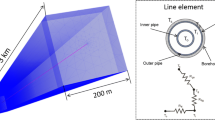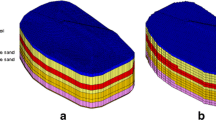Abstract
Wildland urban interface (WUI) communities in the Western United States have recently dealt with historic and devastating wildfires year after year. The fires have cost tens of billions in damage, burned tens of thousands of structures, displaced thousands of residents, and killed hundreds of people. In particular, the 2017 Tubbs fire, 2018 Camp fire, and 2020 Labor Day fires in Oregon caused catastrophic infrastructure losses, and extensive fire damage to the water distribution systems in the towns of Santa Rosa and Paradise CA, and Detroit, OR, respectively. Fire damage caused the water distribution system to become contaminated with volatile organic compounds including benzene, a well-known carcinogen. This study investigates a modeling method to evaluate the heat transfer of wildfires through the soil to quantify if the upper limit temperature for pressure service of common service pipelines is exceeded during a wildfire. This model utilizes one-dimensional transient heat conduction, looking at the effects of surface heat flux, surface temperature, heating duration, thermal diffusivity, and burial depth, on below ground soil temperatures. After considering these effects, the below ground conditions are applied to a representative buried service lateral to assess the influence of increased soil temperatures on buried pipes and the water contained within. For the purposes of this study, the model is run based on service laterals in a typical intermountain West WUI community. Under the wildfire conditions expected in these communities, the model determined that the upper limit temperature for pressure service of the pipelines was exceeded at depths up to 0.45 m. The model’s fragility analysis of burial depths reveals that this upper limit temperature will be exceeded at least 50% of the time at depths up to 0.19 m. This model will provide useful information for municipalities in WUI communities to plan for future resiliency against wildfires.












Similar content being viewed by others
References
Radeloff VC, Helmers DP, Kramer HA, Mockrin MH, Alexandre PM, Bar-Massada A, Batusic V, Hawbaker TJ, Martinuzzi S, Syphard AD, Stewart SI (2018) Rapid growth of the US wildland-urban interface raises wildfire risk. PNAS 115(13):3314–3319. https://doi.org/10.1073/pnas.1718850115
Cal Fire (a) (2020) Top 20 most destructive California wildfires. Accessed 28 March 2021. https://www.fire.ca.gov/media/t1rdhizr/top20_destruction.pdf
Kasler D (2017) Wine country wildfires costs now top $9 billion, costliest in California’s history. The Sacramento Bee. Accessed 15 May 2021. https://www.sacbee.com/news/california/fires/article188377854.html
Löw P (2019) The natural disasters of 2018 in figures: Losses in 2018 dominated by wildfires and tropical storms. Munich Re Group. Accessed 12 May 2021. https://www.munichre.com/topics-online/en/climate-change-and-natural-disasters/natural-disasters/the-natural-disasters-of-2018-in-figures.html
Cal Fire (2018). Wildfire activity statistics. California Department of Forestry and Fire Protection. Sacramento
Cal Fire (b) (2020) 2020 Fire Siege. California Department of Forestry and Fire Protection. Sacramento
Urness Z, Poehler B (2020) Oregon wildfires: Idyllic Detroit 'looks like a war zone' after wildfires flatten Lakeside Town. Statesman Journal, Salem Statesman Journal, https://www.statesmanjournal.com/story/news/2020/09/14/oregon-wildfires-detroit-damage-lakeside-town-lionshed-beachie-creek-fire/5791420002/ (Nov. 16, 2021).
USDA Forest Service Fire and Aviation Management (2020) Beachie Creek fire. Beachie Creek Fire Information - InciWeb the Incident Information System, InciWeb, https://inciweb.nwcg.gov/incident/7001/ (Nov. 16, 2021)
USDA Forest Service Fire and Aviation Management (2020) Lionshead fire. Lionshead Fire Information - InciWeb the Incident Information System, InciWeb, https://inciweb.nwcg.gov/incident/7049/ (Nov. 16, 2021)
U.S. Environmental Protection Agency (U.S. EPA) (1992) Method 524.2: measurement of purgeable organic compounds in water by capillary column gas chromatography/mass spectrometry. Revision 4.1. Cincinnati
Paradise Irrigation District (2019) Water system recovery plan. Paradise Irrigation District: Paradise
Schulze SS, Fischer EC, Hamideh S, Mahmoud H (2020) Wildfire impacts on schools and hospitals following the 2018 California Camp Fire. Nat Hazards 104:901–925. https://doi.org/10.1007/s11069-020-04197-0
Duffy DP (2019) The perfect pipe. Water World. Accessed 12 May 2021. https://www.waterworld.com/home/article/14071043/the-perfect-pipe#:~:text=The%20most%20common%20pipe%20diameter,diameter%20up%20to%206%20inches
Schulze SS, Fischer EC (2021) Prediction of water distribution system contamination based on wildfire burn severity in wildland urban interface communities. ACS EST Water 1(2):291–299. https://doi.org/10.1021/acsestwater.0c00073
City of Detroit (2021) Water system update. Detroit Oregon, City of Detroit, https://detroitoregon.us/water-systems-update (Nov. 16, 2021)
City of Santa Rosa Water Department (2018) Post-fire water quality investigation: analysis of cause of water contamination. Technical memorandum 1. Santa Rosa
Chong NS, Abdulramoni S, Patterson D, Brown H (2019) Releases of fire-derived contaminants from polymer pipes made of polyvinyl chloride. Toxics 7(4):1–14. https://doi.org/10.3390/toxics7040057
Isaacson KP, Proctor CR, Wang QE, Edwards EY, Noh Y, Shah AD, Whelton AJ (2021) Drinking water contamination from the thermal degradation of plastics: implications for wildfire and structure fire response. Environ Sci 7:274–284. https://doi.org/10.1039/D0EW00836B
Proctor CR, Lee J, Yu D, Shah AD, Whelton AJ (2020) Wildfire caused widespread drinking water distribution network contamination. AWWA Wat Sci. https://doi.org/10.1002/aws2.1183
Carslaw HC, Jaeger JC (1959) Conduction of heat in soils, 2nd edn. Oxford University Press, London
Wells CG, Campbell RE, DeBano LF, Lewis CE, Fredriksen RL, Franklin EC, Froelich RC, Dunn PH (1979) Effects of fire on the soil: a state-of-the-knowledge review. USDA Forest Service General Technical Report WO-7.
Abu-Hamdeh NH, Reeder RC (2000) Soil thermal conductivity: effects of density, moisture, salt concentration, and organic matter. Soil Sci Soc Am J 64:1285–1290. https://doi.org/10.2136/sssaj2000.6441285x
Campbell GS, Jungbauer JD Jr, Bidlake WR, Hungerford RD (1994) Predicting the effect of temperature on soil thermal conductivity. Soil Sci 158(5):307–313. https://doi.org/10.1097/00010694-199411000-00001
Ochsner TE, Horton R, Ren T (2001) A new perspective on soil thermal properties. Soil Sci Soc Am J 65:1641–1647. https://doi.org/10.2136/sssaj2001.1641
Smits KM, Kirby E, Massman WJ, Baggett LS (2016) Experimental and modeling study of forest fire effect on soil thermal conductivity. Pedosphere 26(4):462–473. https://doi.org/10.1016/S1002-0160(15)60057-1
De Vries DA (1963) Thermal properties of soils. In: van Wijk WR (ed) Physics of plant environment. North-Holland Publishing Company, Amsterdam
Abu-Hamdeh NH (2003) Thermal properties of soils as affected by density and water content. Biosyst Eng 86(1):97–102. https://doi.org/10.1016/S1537-5110(03)00112-0
Scotter DR (1970) Soil temperatures under grass fires. Aust J Soil Res 8:273–279. https://doi.org/10.1071/SR9700273
Massman WJ, Frank JM, Shepperd WD, Platten MJ (2003) In situ soil temperature and heat flux measurements during controlled surface burns at a Southern Colorado forest site. USDA Forest Service Proceedings RMRS-P-29:69–88
Chandler C, Cheney P, Thomas P, Trabaud L, Williams D (1983) Fire in forestry: volume II forest fire management. Wiley, New York
Rehm RG, Hamins A, Baum HR, McGrattan KB, Evans DD (2002) Community-scale fire spread. In: Proceedings of California’s 2001 wildfire conference: 10 years after the 1991 East Bay Hills Fire
Drysdale D (2011) An introduction to fire dynamics, 3rd edn. Wiley, New York
De Vries DA, Peck AJ (1958) On the cylindrical probe method of measuring thermal conductivity with special reference to soils: 1. Extension of theory and discussion of probe characteristics. Aust J Phys 11(2):255–271. https://doi.org/10.1071/PH580255
Van Rossum G (2020) The Python Library Reference, release 3.8.3, Python Software Foundation
Márquez JMA, Bohórquez MAM, Melgar SG (2016) Ground thermal diffusivity calculation by direct soil temperature measurement. Application to very low enthalpy geothermal energy systems. Sensors 16(3):306. https://doi.org/10.3390/s16030306
Georg Fischer (2010) Schedule 80 PVC and CPVC, schedule 40 PVC piping systems technical manual. Georg Fischer Piping systems, Tustin
Plastic Pipe Institute (2009) Frequently asked questions: HDPE pipe for water distribution and transmission applications. Plastic Pipe Institute, Irving
Home Innovation Research Labs (2013) Design guide residential PEX water supply plumbing systems, 2nd edn. Prepared for Plastic Pipe Institute, Irving
Duran BA (2013) Galvanized steels performance in extreme temperatures. American Galvanizers Association. Accessed 15 Feb 2021. https://galvanizeit.org/knowledgebase/article/galvanized-steel-s-performance-in-extreme-temperatures
Copper Development Association (CDA) (2010) The copper tube handbook. CDA, New York
AWWA (American Water Works Association) (2006) PE pipe—design and installation. AWWA Manual M55. AWWA, Denver
Performance Pipe Technical Note PP 816-TN. 2007. PE3608 & PE4710 material designation codes and pipe pressure ratings. Plano
Silvani X, Morandini F (2009) Fire spread experiments in the field: temperature and heat fluxes measurements. Fire Saf J 44:279–285. https://doi.org/10.1016/j.firesaf.2008.06.004
Kim AK, Lougheed GD (1990) The protection of glazing systems with dedicated sprinklers. J Fire Prot Eng 2(2):49–59. https://doi.org/10.1177/104239159000200202
Quarles SL, Sindelar M (2011) Wildfire ignition resistant home design (WIRHD) program: full-scale testing and demonstration final report. United States. https://doi.org/10.2172/1032503
Cohen J (1995) Structure Ignition Assessment Model (SIAM). USDA Forest Service General Technical Report PSW-GTR-158
Bilskie JR (1994) Dual probe methods for determining soil thermal properties: numerical and laboratory study. Ph.D. Dissertation. Iowa State University
Soil Survey Staff (2019) Web Soil Survey. Natural Resources Conservation Service, United States Department of Agriculture. Accessed 10 Feb 2021. https://websoilsurvey.sc.egov.usda.gov/App/HomePage.htm
Municipal Advisory Board (2020) MAB model specifications for PE 4710 buried potable water service, distribution and transmission pipes and fittings. Plastic Pipe Institute, Irving
IAPMO (International Association of Plumbing and Mechanical Officials) (2021) Uniform plumbing code. IAPMO, Ontario
Rain Bird Corporation (2021) Sprinkler installation guide. Accessed 8 Aug 2021. https://www.rainbird.com/homeowners/sprinkler-system-installation-guide
Richter EG Simulation of Heat Transfer Through Soil for the Investigation of Wildfire Impacts on Buried Utilities. Oregon State University. https://ir.library.oregonstate.edu/concern/graduate_projects/kk91ft25w
Plastic Pipe Institute (PPI) (2008) Second edition handbook of PE pipe. Plastic Pipe Institute, Irving
Baker J (2015) Efficient analytical fragility function fitting using dynamic structural analysis. Earthq Spectra 31(1):579–599. https://doi.org/10.1193/021113EQS025M
Massman WJ, Frank JM, Reisch NB (2008) Long-term impacts of prescribed burns on soil thermal conductivity and soil heating at a Colorado Rocky Mountain site: a data/model fusion study. Int J Wildland Fire 17:131–146. https://doi.org/10.1071/WF06118
Acknowledgements
This research was funded by the Alfred P. Sloan Foundation. The results presented in this paper are the conclusions by the authors and do not reflect the ideas of the funding agency.
Data Availability
Some or all data, models, or code that support the findings of this study are available from the corresponding author upon reasonable request. These include Python code and Excel data files.
Author information
Authors and Affiliations
Corresponding author
Additional information
Publisher’s note
Springer Nature remains neutral with regard to jurisdictional claims in published maps and institutional affiliations.
Rights and permissions
About this article
Cite this article
Richter, E.G., Fischer, E.C., Metz, A. et al. Simulation of Heat Transfer Through Soil for the Investigation of Wildfire Impacts on Buried Pipelines. Fire Technol 58, 1889–1915 (2022). https://doi.org/10.1007/s10694-022-01232-3
Received:
Accepted:
Published:
Issue Date:
DOI: https://doi.org/10.1007/s10694-022-01232-3




